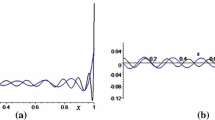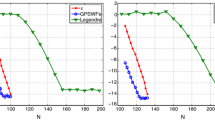Abstract
In this work, we first give various explicit and local estimates of the eigenfunctions of a perturbed Jacobi differential operator. These eigenfunctions generalize the famous classical prolate spheroidal wave functions (PSWFs), founded in 1960s by Slepian and his co-authors and corresponding to the case \(\alpha =\beta =0.\) They also generalize the new PSWFs introduced and studied recently in Wang and Zhang (Appl Comput Harmon Anal 29:303–329, 2010), denoted by GPSWFs and corresponding to the case \(\alpha =\beta .\) The main content of this work is devoted to the previous interesting special case \(\alpha =\beta >- 1.\) In particular, we give further computational improvements, as well as some useful explicit and local estimates of the GPSWFs. More importantly, by using the concept of a restricted Paley–Wiener space, we relate the GPSWFs to the solutions of a generalized energy maximisation problem. As a consequence, many desirable spectral properties of the self-adjoint compact integral operator associated with the GPSWFs are deduced from the rich literature of the PSWFs. In particular, we show that the GPSWFs are well adapted for the spectral approximation of the classical c-band-limited as well as almost c-band-limited functions. Finally, we provide the reader with some numerical examples that illustrate the different results of this work.



Similar content being viewed by others
References
Andrews, G.E., Askey, R., Roy, R.: Special Functions. Cambridge University Press, Cambridge (1999)
Batir, N.: Inequalities for the gamma function. Arch. Math. 91, 554–563 (2008)
Bonami, A., Karoui, A.: Uniform bounds of prolate spheroidal wave functions and eigenvalues decay. C.R. Math. Acad. Sci. Paris Ser. I 352, 229–234 (2014)
Bonami, A., Karoui, A.: Approximations in Sobolev spaces by prolate spheroidal wave functions. (2014) (submitted)
Bonami, A., Karoui, A.: Uniform approximation and explicit estimates of the Prolate Spheroidal Wave Functions, Constr. Approx. (2015). doi:10.1007/s00365-015-9295-1, http://arxiv.org/abs/1405.3676
Bonami, A., Karoui, A.: Spectral decay of time and frequency limiting operator. Appl. Comput. Harmon. Anal. (2015). doi:10.1016/j.acha.2015.05.003
Boyd, J.P.: Approximation of an analytic function on a finite real interval by a band-limited function and conjectures on properties of prolate spheroidal functions. Appl. Comput. Harmon. Anal. 25(2), 168–176 (2003)
Boyd, J.P.: Prolate spheroidal wave functions as an alternative to Chebyshev and Legendre polynomials for spectral element and pseudo-spectral algorithms. J. Comput. Phys. 199, 688–716 (2004)
Hogan, J.A., Lakey, J.D.: Duration and Bandwidth Limiting: Prolate Functions, Sampling, and Applications. Applied and Numerical Harmonic Analysis Series. Birkhäser, New York (2013)
Karoui, A., Moumni, T.: New efficient methods of computing the prolate spheroidal wave functions and their corresponding eigenvalues. Appl. Comput. Harmon. Anal. 24(3), 269–289 (2008)
Landau, H.J., Pollak, H.O.: Prolate spheroidal wave functions, Fourier analysis and uncertainty—III. The dimension of space of essentially time-and band-limited signals. Bell Syst. Tech. 41, 1295–1336 (1962)
Niven, C.: On the conduction of heat in ellipsoids of revolution. Philos. Trans. R. Soc. Lond. 171, 117–151 (1880)
Olver, Frank W., Lozier, Daniel W., Boisvert, Ronald F., Clark, Charles W.: NIST Handbook of Mathematical Functions, 1st edn. Cambridge University Press, New York (2010)
Osipov, A.: Certain inequalities involving prolate spheroidal wave functions and associated quantities. Appl. Comput. Harmon. Anal. 35, 359–393 (2013)
Slepian, D.: Prolate spheroidal wave functions, Fourier analysis and uncertainty—IV: Extensions to many dimensions; generalized prolate spheroidal functions. Bell Syst. Tech. J. 43, 3009–3057 (1964)
Slepian, D., Pollak, H.O.: Prolate spheroidal wave functions, Fourier analysis and uncertainty I. Bell Syst. Tech. J. 40, 43–64 (1961)
Szegö, G.: Orthogonal polynomials, American Mathematical Society, Colloquium Publications, vol. 23, 4th edn. American Mathematical Society, Providence (1975)
Wang, L.L.: Analysis of spectral approximations using prolate spheroidal wave functions. Math. Comput. 79(270), 807–827 (2010)
Wang, L.L., Zhang, J.: A new generalization of the PSWFs with applications to spectral approximations on quasi-uniform grids. Appl. Comput. Harmon. Anal. 29, 303–329 (2010)
Xiao, H., Rokhlin, V., Yarvin, N.: Prolate spheroidal wave functions, quadrature and interpolation. Inverse Probl. 17, 805–838 (2001)
Acknowledgments
This work was supported by the DGRST research Grant UR13ES47. The authors thank very much the anonymous referees for their valuable comments that have improved this work.
Author information
Authors and Affiliations
Corresponding author
Additional information
Communicated by Hans G. Feichtinger.
Appendix: Proof of Theorem 1
Appendix: Proof of Theorem 1
The proof is divided into three steps. To alleviate notations of this proof, we will simply denote \(\psi _{n,c}^{(\alpha )}\) and \(\chi _n(c)\) by \(\psi _{n,c}\) and \(\chi _n,\) respectively.
First step: We prove that for for any positive integer j with \(j(j+2\alpha +1)\le \chi _n\), all moments \(\int _{-1}^1 y^j \psi _{n,c}(y)\, dy\) are non negative and
To this end, we first check that for any integer \( k\ge 0\) satisfying \(k(k+2\alpha +1)\le \chi _n,\) we have
It suffices to prove that \( m_k=\frac{|\psi _{n,c}^{(k)}(0)|}{\sqrt{\chi _n}^k} \le \sqrt{1+\alpha }.\) From the parity of \(\psi _{n,c},\) we need only to consider derivatives of even or odd order. We assume that \(n=2l\) is even. The case where n is odd is done in a similar manner. Note that for a fixed n, \( \psi _{n,c}^{(2l)}(0) \) has alternating signs, that is \( \psi _{n,c}^{(k)}(0) \psi _{n,c}^{(k-2)}(0)<0 \) In fact, for \(k=0,\) we have \( \psi _{n,c}(0)\psi _{n,c}^{(2)}(0)=-\chi _n\psi _{n,c}(0)^2<0.\) By induction, we assume that \( \psi _{n,c}^{(k)}(0) \psi _{n,c}^{(k-2)}<0 .\) As it is done in [6], we have
By using the induction hypothesis as well as the fact that \( k(k+1+\alpha +\beta ) \le \chi _n,\) one concludes that the induction assumption holds for the order k. Consequently, we have
The previous equality implies that
Hence, for any positive and even integer k with \(k(k+2\alpha +1)\le \chi _n,\) we have \(m_k\le m_0\le \sqrt{1+\alpha }.\) This last inequality follows from (32) with \(t=0.\) This proves the inequality (74). Moreover, by taking the jth derivative at zero on both sides of \({\int _{-1}^1 e^{icxy} \psi _{n,c}(y)\omega _{\alpha }(y) dy =\mu _n^{(\alpha )}(c) \psi _{n,c}(x),}\) one gets
Since \(\psi _{n}^{(j)}(0)\) and \(\psi _{n}^{(j+2)}(0)\) have opposite signs, then the previous equation implies that all moments with even order j with \(j(j+2\alpha +1)\le \chi _n\) have the same sign. The inequality (73) follows from (74).
Second step: We show that for all positive integers k, n with \(k(k+2\alpha +1)+C_{\alpha }\, c^2\le \chi _n(c)\), we have \(\beta _k^n\ge 0.\) Here \(C_{\alpha }\) is as given by (53). The positivity of \(\beta _0^n\) (when n is even) and \(\beta _1^n\) (when n is odd) follow from the fact that
Since the \(\beta _k^n\) are given by (24), then by using the hypothesis of the theorem, we have
For \(j\ge 2\) and by rearranging the system (24) and using the induction hypothesis \(\beta _j^n \ge \beta _{j-2}^n \ge 0,\) one gets
where \(M_{\alpha }\) and \(N_{\alpha }\) are as given by (53). If we suppose that \(\beta _{j+2} \le \beta _j^n,\) then from (80), one gets
which contradicts the choice of \( C_{\alpha } \) and the fact that \(k(k+2\alpha +1)+C_{\alpha }\, c^2\le \chi _n(c).\) Hence, the induction hypothesis holds for \(\beta _{j+2}^n.\)
Third step: We prove (52). The first inequality follows from (79) and (74). To prove the second inequality, we recall that the moments \(M_{j,k}\) of the normalized Jacobi polynomials \({\widetilde{P}}_k^{(\alpha ,\alpha )}\) are given by (17) and they are non-negative. Moreover, since \({\displaystyle x^j=\sum \nolimits _{k=0}^j M_{jk} {\widetilde{P}}_k^{(\alpha ,\alpha )}(x),}\) then the moments of the \(\psi _{n,c}\) are related to the GPSWFs series expansion coefficients by the following relation
Since from the previous step, we have \(\beta _k^n \ge 0,\) for any \(0\le k\le j\) and since the \(a_{jk}\) are non negative, then the previous equality implies that
The last inequality follows from the result of the first step. Moreover, by using the explicit expression of \(M_{j,j},\) given by (17), together with (10), (51), the decay of the function \(\varphi ,\) given by (13), as well as some straightforward computations, one obtains
Finally, by combining (82) and (83), one gets the second inequality of (52). \(\square \)
Rights and permissions
About this article
Cite this article
Karoui, A., Souabni, A. Generalized Prolate Spheroidal Wave Functions: Spectral Analysis and Approximation of Almost Band-Limited Functions. J Fourier Anal Appl 22, 383–412 (2016). https://doi.org/10.1007/s00041-015-9420-3
Received:
Revised:
Published:
Issue Date:
DOI: https://doi.org/10.1007/s00041-015-9420-3
Keywords
- Sturm–Liouville operators
- Finite weighted Fourier transform
- Eigenvalues and eigenfunctions
- Special functions
- Prolate spheroidal wave functions
- Band-limited functions




